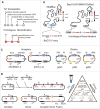Baculovirus expression: old dog, new tricks
- PMID: 26488462
- PMCID: PMC4825837
- DOI: 10.1080/21655979.2015.1104433
Baculovirus expression: old dog, new tricks
Abstract
Since its inception more than 30 years ago, the baculovirus expression vector system (BEVS) has been used prolifically to produce heterologous proteins for research and development. In the cell, a cornerstone of biological activity are multiprotein complexes, catalyzing essential functions. BEVS has been uniquely successful to unlock such complex assemblies for high-resolution structural and functional analysis. Synthetic biology approaches have been implemented to optimize multigene assembly methods, accelerating upstream processes. Specialized baculoviral genomes are being created with functions tailored to enhance production of particular target protein classes. Here we comment on current and emerging developments in the field and their potential to accelerate protein complex research.
Keywords: DNA recombineering; automation; baculovirus; insect cell culture; multiprotein complex; protein modification; recombinant expression; structural biology; synthetic biology.
Figures


Similar articles
-
New baculovirus expression tools for recombinant protein complex production.J Struct Biol. 2010 Oct;172(1):45-54. doi: 10.1016/j.jsb.2010.02.010. Epub 2010 Feb 21. J Struct Biol. 2010. PMID: 20178849
-
Expressing Multi-subunit Complexes Using biGBac.Methods Mol Biol. 2018;1764:329-343. doi: 10.1007/978-1-4939-7759-8_21. Methods Mol Biol. 2018. PMID: 29605925
-
Fundamentals of Baculovirus Expression and Applications.Adv Exp Med Biol. 2016;896:187-97. doi: 10.1007/978-3-319-27216-0_12. Adv Exp Med Biol. 2016. PMID: 27165326 Review.
-
Baculovirus expression system for heterologous multiprotein complexes.Nat Biotechnol. 2004 Dec;22(12):1583-7. doi: 10.1038/nbt1036. Epub 2004 Nov 28. Nat Biotechnol. 2004. PMID: 15568020
-
MultiBac: Baculovirus-Mediated Multigene DNA Cargo Delivery in Insect and Mammalian Cells.Viruses. 2019 Feb 26;11(3):198. doi: 10.3390/v11030198. Viruses. 2019. PMID: 30813511 Free PMC article. Review.
Cited by
-
Structural Characterization of Canine Minute Virus, Rat and Porcine Bocavirus.Viruses. 2023 Aug 24;15(9):1799. doi: 10.3390/v15091799. Viruses. 2023. PMID: 37766206 Free PMC article.
-
The Structural, Biophysical, and Antigenic Characterization of the Goose Parvovirus Capsid.Microorganisms. 2025 Jan 3;13(1):80. doi: 10.3390/microorganisms13010080. Microorganisms. 2025. PMID: 39858848 Free PMC article.
-
Characterization of the Serpentine Adeno-Associated Virus (SAAV) Capsid Structure: Receptor Interactions and Antigenicity.J Virol. 2022 Jun 8;96(11):e0033522. doi: 10.1128/jvi.00335-22. Epub 2022 May 9. J Virol. 2022. PMID: 35532224 Free PMC article.
-
Protein Expression Platforms and the Challenges of Viral Antigen Production.Vaccines (Basel). 2024 Nov 28;12(12):1344. doi: 10.3390/vaccines12121344. Vaccines (Basel). 2024. PMID: 39772006 Free PMC article. Review.
-
MultiBac: from protein complex structures to synthetic viral nanosystems.BMC Biol. 2017 Oct 30;15(1):99. doi: 10.1186/s12915-017-0447-6. BMC Biol. 2017. PMID: 29084535 Free PMC article. Review.
References
-
- Almo SC, Garforth SJ, Hillerich BS, Love JD, Seidel RD, Burley SK. Protein production from the structural genomics perspective: achievements and future needs. Curr Opin Struct Biol 2013; 23(3):335; PMID:23642905; http://dx.doi.org/10.1016/j.sbi.2013.02.014 - DOI - PMC - PubMed
-
- Berger I, Mayr LM. Protein production for structural biology: new solutions to new challenges. Curr Opin Struct Biol 2013; 23(3):317; PMID:23735677; http://dx.doi.org/10.1016/j.sbi.2013.05.004 - DOI - PubMed
-
- Aricescu AR, Owens RJ. Expression of recombinant glycoproteins in mammalian cells: towards an integrative approach to structural biology. Curr Opin Struc Biol 2013; 23(3):345; http://dx.doi.org/10.1016/j.sbi.2013.04.003 - DOI - PMC - PubMed
-
- Bieniossek C, TImasaki , Takagi Y, Berger I. MultiBac: expanding the research toolbox for multiprotein complexes. Trends Biochem Sci 2012; 37(2):49; PMID:22154230; http://dx.doi.org/10.1016/j.tibs.2011.10.005 - DOI - PMC - PubMed
-
- Barford D, Takagi Y, Schultz P, Berger I. Baculovirus expression: tackling the complexity challenge. Curr Opin Struct Biol 2013; 23(3):357; PMID:23628287; http://dx.doi.org/10.1016/j.sbi.2013.03.009 - DOI - PMC - PubMed
Publication types
MeSH terms
Substances
LinkOut - more resources
Full Text Sources
Other Literature Sources
